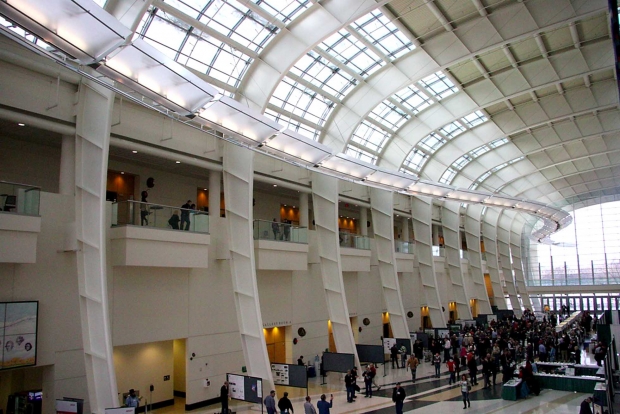
The main hall on the opening day of the Great Lakes Expo in Grand Rapids on Dec. 10, 2013. TJ Mullinax/Good Fruit Grower
Three themes dominated the tree fruit portion of the Great Lakes Fruit, Vegetable, and Farm Market Expo, held this week in Grand Rapids, Michigan.
The three: Bees and the need for growers to take greater care to protect them and other pollinators; the creation of the Michigan Tree Fruit Commission, which is slated to be voted upon in February; and fruiting walls for apples.
Dr. Mary Ann Frazier brought the main bee message; the Penn State apiculturist said there is mounting evidence that fungicides applied near bloom are a problem.
While not directly toxic to bees themselves, they amplify—by a factor of 2,000 times or more—the effects of insecticides and miticides.
Even the miticides beekeepers use to subdue the varroa mites that parasitize bees directly can become lethal to bees when the synergizing effect of fungicides add to the mix.
Two Michigan State University entomologists, Dr. Mark Whalon and Dr. Matt Grieshop, reinforced the message.
Whalon said that beekeepers have aroused the entire nation about the plight of honeybees, resulting in intense political pressure on members of Congress who, in response, have turned up the heat on the Environmental Protection Agency to do something about the crisis.
He expects EPA will do something, and soon.
Grieshop began preliminary research last year to find ways to reduce apple scab and other disease inoculum in orchards so the need to use fungicides during the critical bloom period will be reduced.
A group of ten Michigan fruit industry leaders—growers of apples, peaches, cherries, and plums—was appointed last summer as interim directors of what may become the Michigan Tree Fruit Commission.
They spoke several times in several fruit sessions to encourage growers to vote yes in February for creation of the commission.
The commission’s mission, once created, will be to generate about $675,000 a year to support Michigan State University research and extension, with special emphasis on maintaining the facilities at the four Michigan fruit experiment stations.
Dr. Alberto Dorigoni, a tree fruit researcher from Italy’s most northeastern county at the foot of the Alps—the Tyrol region—made two presentations on fruiting walls.
Dorigoni spoke a year ago at the International Tree Fruit Association meeting in Boston and made such a hit researchers at Cornell University and Michigan State University immediately began studying his methods and growers began adopting them. By summer, growers in New York and Michigan had converted some of their tall spindle orchards into fruiting walls using mechanical hedgers.
He packed the room at the Expo, as growers wanted to hear more.
The Expo, again this year, had record attendance. Allyn Anthony, executive secretary of the Michigan State Horticultural Society, said exhibitor space was sold out and nearby hotels sold out of rooms months in advance.
As the show began its third day, trade show manager Sharri German said registrations had topped 4,100, a record, and exhibitor numbers reached 425 companies, 60 more than last year, a record.
“We’re almost to the walls,” she said. Growers from 45 states and nine Canadian provinces attended the three-day show December 10-12.






Leave A Comment